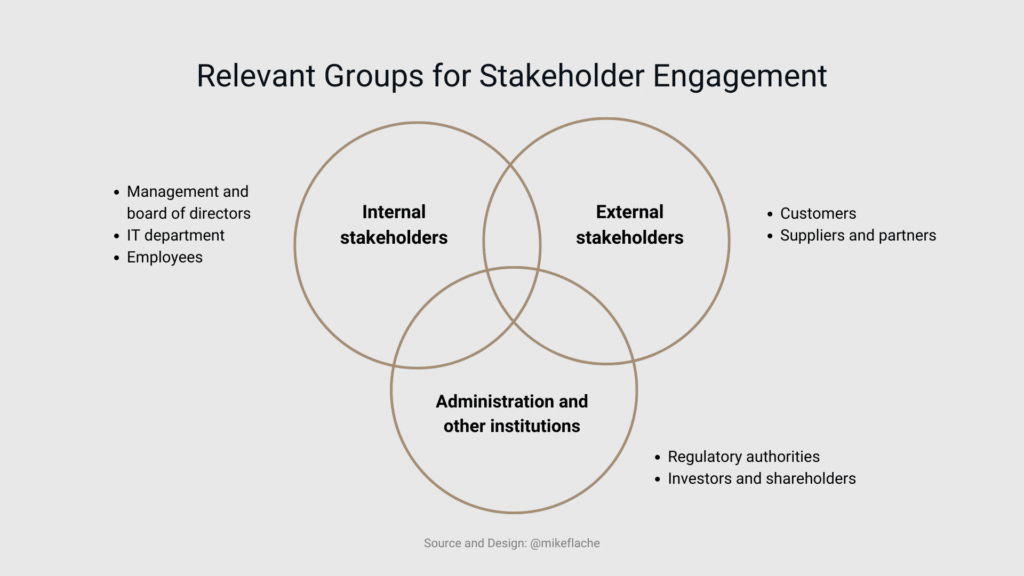Key takeaways
- Stakeholder engagement is crucial for the success of digital transformation projects. By involving employees, customers, investors, and other key stakeholders early on, organizations can foster support and acceptance and minimize resistance to change.
- Engaging stakeholders helps mitigate risks and improve strategy development. The diverse perspectives and expertise of stakeholders provide valuable insights, leading to more comprehensive and resilient strategies while identifying potential risks early.
- Transparent communication and effective change management create trust and support. Clear, consistent communication about the benefits of new technologies and support for employees during the transformation process is essential to reduce uncertainty and ensure the success of digital initiatives.
Organizations striving for digital growth continue to face a core challenge: the majority of digital transformation projects fall short of expectations.
Whether Deloitte, McKinsey, or Boston Consulting Group, they all come up with a good 70 percent in their studies. That has not changed much in the AI age.
The reasons are varied. In my experience, a key aspect is that stakeholder engagement is neglected.
Why is that?
One of the main reasons is the time pressure and urgency with which digital transformation projects are approached.
Executives and project managers are often pressured to deliver quick results and implement the digital strategy as quickly as possible.
In this rush, stakeholder involvement can be perceived as time-consuming and obstructive, which means their contributions and concerns may not be sufficiently considered.
Why stakeholder engagement is crucial
From the perspective of the board of directors and the management, stakeholder engagement plays a central role. It essentially involves:
Ensuring broad support and acceptance of change
- Involving key stakeholders such as employees, customers, suppliers and investors
- Taking their needs and concerns into account
- Building trust and minimizing resistance
Identifying and leveraging synergies through stakeholder engagement
- Bringing in unique perspectives and expertise
- Providing valuable insights and innovative ideas
- Developing comprehensive and robust strategies
Contributing to risk mitigation through stakeholder involvement
- Early detection and addressing of potential risks and challenges
- Increasing the chances of success in implementing the digital strategy
Signaling appreciation for collaboration and transparency through intensive stakeholder engagement
- Strengthening trust in leadership
- Positively influencing the corporate culture
Stakeholders are diverse
That also applies to the challenges and opportunities associated with their involvement.
In my discussions with decision-makers, I find that stakeholders are not always clearly defined. The following graphic shows relevant groups for stakeholder engagement:

Five relevant steps for stakeholder engagement
1. Identification and analysis of stakeholders
The first task is to identify all relevant stakeholders and analyze their interests and expectations. Stakeholders can be internal parties, such as employees and departments, and external parties, such as customers, suppliers, investors, and regulators.
It is crucial to understand the different perspectives and needs of these groups to develop a comprehensive strategy that takes everyone into account.
2. Integration of stakeholder perspectives
After the stakeholders have been identified and their opinions have been obtained, the board and management must integrate these perspectives into the development of the digital strategy. That requires careful consideration of the various interests and the ability to find compromises.
It is critical to develop a strategy that is both technology-driven and people-centered to ensure stakeholder acceptance and support.
3. Communication and transparency
Another relevant task is to ensure effective and transparent communication with stakeholders. The board of directors and the management must communicate clearly and understandably why digital technologies are being introduced and what benefits they offer.
It is crucial to reduce uncertainty and fear and build trust. That requires regular updates, open dialogues, and the involvement of stakeholders in the decision-making process.
4. Resources and skills
The implementation of digital technologies requires appropriate resources and skills. The board and management is faced with the task of ensuring that the organization has the necessary financial resources, technical infrastructure, and qualified employees. That can include training employees, hiring specialists, or working with external partners.
It is critical to find a balance between investing in new technologies and the sustainable use of existing resources.
5. Change management
One of the most critical tasks is to manage change effectively. The introduction of digital technologies can bring about profound changes in work processes and corporate culture.
The board and management must develop strategies to overcome resistance and promote the acceptance of new technologies. That includes creating a culture of innovation, setting an example of willingness to change, and supporting employees throughout the transformation process.
Conclusion
In summary, stakeholder engagement is crucial for developing a strategy that enables digital growth. It ensures broad support and acceptance, promotes trust, and minimizes resistance.
By involving various stakeholders, valuable synergies can be identified and exploited, resulting in a more comprehensive and robust strategy.
In addition, ongoing engagement helps to identify and manage potential risks early on, increasing the chances of success of the digital transformation and strengthening trust in leadership.

